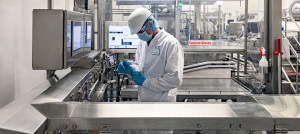Abbott Laboratories Plans $536M Factory in Ohio
A new facility in Bowling Green will make ingredients for baby formula and other products.

Abbott Laboratories worker in a nutritional products facility. Image courtesy of Abbott Laboratories
Months after a baby formula shortage sent parents and caregivers scrambling to find enough products to feed their infants, leading manufacturer Abbott Laboratories said Thursday it will expand production in the U.S. with a $536 million plant in Bowling Green, Ohio.
The new facility, located at the corner of Ohio 25 and Nims Road in the northwest Ohio city, will create 450 permanent jobs in the region, according to Gov. Mike DeWine, who made the announcement along with Lt. Gov. Jon Husted and JobsOhio President & CEO J.P. Nauseef. Groundbreaking is expected in early 2023 with completion of the project in 2026. Production should begin by 2027.
The project is contingent on the approval of state and local incentives. However, the Bowling Green City Council met Thursday to approve agreements with the company for a 15-year, 100 percent tax abatement, according to BG Independent News. The Bowling Green school district is expected to receive annual payments from Abbott totaling $265,826, the online publication reported.
READ ALSO: Industrial Subleasing Strategies
The state-of-the-art plant will produce specialty and metabolic powder nutritional products, creating additional U.S. supply of these essential formulas, some of which serve as the sole source of nutrition for people with extreme allergies to most food products and other dietary and metabolic conditions. The products will be used by infants, children and adults with special dietary needs.
Upon completion of the new factory, Abbott plans to continue operating its Sturgis, Mich., plant, including producing specialty and metabolic powder formulas to help maintain the supply of the critical products.
The Sturgis facility, which currently produces about one-fifth of the infant formula in the U.S., shut down several times this year starting in February when the Food and Drug Administration found traces of a potentially deadly bacteria that may have contaminated products and caused illnesses in some infants. Abbott has said there was no definitive link but the FDA could not rule it out either. The closure lasted several months and contributed to a shortage of infant formula in the U.S., forcing the Biden administration to begin shipping in products from Europe, Mexico, Australia and other locations. A severe storm in early summer also knocked the plant out of commission for several more weeks.
In designing the new Ohio plant, Abbott said it intends to engage with experts on food safety, quality and good manufacturing practices.
Ohio connections
DeWine said in a prepared statement Abbott’s history in formula production goes back to the early 1900s in Columbus. The Chicago-based multinational health-care company continues to have a manufacturing presence in Columbus. He said the new facility in Bowling Green will support job growth and improve the supply chain for critical formula products nationwide.
Husted stated Abbott had many other states courting them for the investment and it was rewarding that Ohio was chosen for the facility. Abbott’s decision to locate in Bowling Green reportedly included nearby access to Interstate 175, high-quality infrastructure, strong community partnerships and proximity of Bowling Green State University.
JobsOhio, a private nonprofit corporation designed to drive job creation and new capital investment in the state, plans to provide financial assistance for the projects. Details are expected to be made public after a final agreement is executed.
In addition to the DeWine-Husted administration and JobsOhio, other entities that worked to bring the Abbott facility to Bowling Green include the Ohio Department of Development, Northwest Ohio’s Regional Growth Partnership (RGP), Bowling Green Economic Development and other state, local and county partners.
The Abbott announcement comes about three months after Intel broke ground on the first two semiconductor manufacturing plants on a nearly 1,000-acre site in New Albany, Ohio. Intel announced the $20 billion project in January and expects to begin production as soon as 2025. The initial $20 billion investment is expected to create 7,000 construction jobs and 3,000 permanent jobs. At full buildout, the investment could be as much as $100 billion over a decade.
In May, SEMCORP Advanced Materials Group selected Sidney, Ohio, for a $916 million manufacturing facility that will make separator film, a key component in batteries for electric vehicles. The largest foreign direct investment in Ohio, the plant is expected to create nearly 1,200 jobs.







You must be logged in to post a comment.